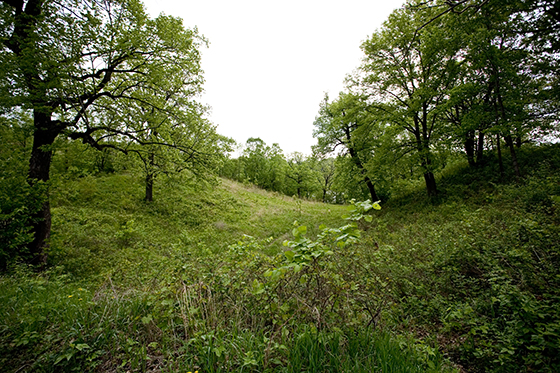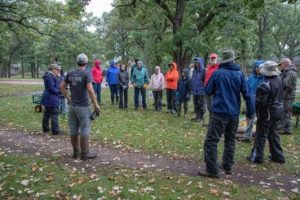Overview
The Mississippi River Gorge, in the heart of the Twin Cities in Minnesota, is one of the most significant features of the entire 2,350-mile long Mississippi River. Oak savanna was once a common ecosystem in Minnesota, covering about 10% of the state, but it is now rare habitat because of fire suppression activities, farming, and development. Oak savannas are highly diverse because they are transition zones from woodland to prairie. An oak savanna restoration project has been implemented and continues to be maintained by local volunteers along a 5-acre stretch of the Mississippi River Gorge in the Minneapolis neighborhood called Longfellow. The project seeks to eliminate the threat of exotic species, reintroduce the appropriate gorge plant community, and address erosion concerns with the collaborative effort of national and local agencies, and the advocacy of the local community.
Quick Facts
Project Location:
Mississippi Gorge Regional Park, 3349 W River Pkwy, Minneapolis, MN 55406, USA, 44.9383761835049, -93.20288208326667
Geographic Region:
North America
Country or Territory:
United States of America
Biome:
Grassland/Savanna
Ecosystem:
Grasslands & Savannas - Temperate
Area being restored:
5 acres
Project Lead:
National Park Service
Organization Type:
Governmental Body
Project Partners:
Longfellow Community Council
Minneapolis Park and Recreation Board
Friends of the Mississippi River
Location
Project Stage:
Planning / Design
Start Date:
2013
End Date:
2019
Primary Causes of Degradation
Invasive Species (native or non-native pests, pathogens or plants), Urbanization, Transportation & IndustryDegradation Description
Fire suppression has prevented the periodic clearing of understory vegetation typical of oak savannas. As a result, buckthorn and other invasive, exotic plants have become established in a thicket and crowded out native prairie species. Heavy recreational use along the Mississippi Gorge area has caused erosion issues. In some places, erosion was so severe that gullies had formed and sediment washed into the river during heavy rains.
Defining the Reference Ecosystem
The reference ecosystem is primarily based on historical information about ecological attributes at the site prior to degradation.Reference Ecosystem Description
The prairies of North America were once vast grasslands that covered 200 million acres, a complex ecosystem supporting a large amount of wildlife. Today, less than one percent of that native habitat is left. Prairies are composed of many species of grasses and forbs (wildflowers). Animals such as gophers, hawks, and bison, in addition to many native insects rely on prairie ecosystems. Oak savannas are a community of scattered oak trees (Quercus spp.) above a layer of prairie grasses and forbs that once covered 10% of Minnesota. The trees are spaced enough so that there is little to no closed canopy and the grasses and forbs receive plentiful amounts of sunlight. The savanna is often thought of as a transition system between the tallgrass prairie and woodland environments, but may contain species that are found only in it and not in either forest or prairie. As a result, it is an important and diverse system containing species from both woodland and prairie, but containing some species that is unique to only savanna. Savannas rely on periodic disturbances such as fire, grazing, and drought to flourish. Such disturbances prevent most tree species from establishing themselves and turning the habitat into a forest community. Fire-adapted trees, such as bur oak trees with their thick, corky bark, and prairie grasses are resilient to fire and do well in environments where fire is a common occurence. Oak savannas are highly diverse ecosystems, so measuring diversity following restoration is a measure of health and stability of the ecosystem.
Project Goals
- Eradicate exotic species in the area.
- Reintroduce and restore native oak savanna species and the appropriate community distribution.
- Engage the local community in interpretive events and volunteer activities.
Monitoring
The project does not have a monitoring plan.
Stakeholders
The land is owned by the Minneapolis Park and Recreation Board, but this area of the gorge in the Longfellow neighborhood is part of the 72-mile stretch of the river that is designated national park. Following community advocacy for restoring the area and addressing erosion issues, project partners – the Longfellow Community Council, Minneapolis Park and Recreation Board, and National Park Service – developed a plan to guide restoration efforts. Volunteers from the local community organized by Friends of the Mississippi River and Ecological Strategies embraced these restoration efforts in the past six years by participating in invasive species removal, litter clean up, seed collection, planting, and through strengthening their ties to the gorge at interpretive events. Thanks to the collaboration of many partner organizations and countless hours of volunteer service for more than ten years, the area that was once a buckthorn thicket is now showing signs of renewed life.
How this project eliminated existing threats to the ecosystem:
To address the erosion issues, the eroded gullies were filled with soil and seeded with native grasses and flowers. Signs were also posted asking hikers and other recreationists to remain on the designated trails. In some places, temporary fences were installed as an added protection measure. At steeper portions of the trails, erosion control bars and stairs are being installed.
How this project reinstated appropriate physical conditions (e.g. hydrology, substrate)",:
Measures have also been taken to reestablish vegetation on paths where it had been worn away and soil exposed from people traveling up and down the bluff, off designated trails, to access the river. Buckthorn and other non-native woody plants, as well as some native trees, were removed to restore the openness of mesic oak savanna forest. The stumps of the exotic species were treated with an herbicide to prevent regrowth. A prescribed burn plan was developed as part of the maintenance plan.
How this project achieved a desirable species composition:
Native prairie plants were planted. Volunteer groups continue to remove exotic species like sweet clover, reed canary grass, and garlic mustard and maintain existing plantings and the collection and spreading of desirable native seed at this site designated as oak brushland that is being restored to oak savanna.
Ecological Outcomes Achieved
Reinstate appropriate physical conditions",:
The project has restored the open landscape typical of oak savanna and doubled the amount of mesic oak savanna in the metropolitan area.
Achieve a desirable species composition:
Native plants appropriate to the oak savanna gorge community have returned to the area.
Socio-Economic & Community Outcomes Achieved
Cultural dimensions such as recreational, aesthetic and/or spiritual:
Ecological Strategies hosts Oak Savanna Workdays in the Longfellow restoration project area which offer an opportunity for local residents to learn more about this site, create a special place for residents of gorge neighborhoods and thousands of annual visitors, and instill a sense of connection to the river gorge area in visitors through interpretive activities.
Long-Term Management
Following the clearing, resource specialists will carry out prescribed burns each spring for three years to maintain the forest opening and allow prairie plants and shrubs to become reestablished.
Volunteers will continue to help remove buckthorn, revegetate eroding areas, and collect seeds from mature prairie plants for use in future restoration projects. Going forward, volunteers will continue ongoing efforts to keep the area free of buckthorn and other invasive plants are critical to the project’s success.
Sources and Amounts of Funding
Initial neighborhood funding from the Neighborhood Revitalization Program was leveraged by additional funds from Minneapolis Park and Recreation Board, Minnesota Department of Natural Resources, the National Park Service, and the Mississippi Watershed Management Organization to total more than $400,000 used to complete hardscape projects such as repair to a sewer outfall at 36th Street and a new staircase near 33rd Street. In addition to these new park structures, funds were used to create a plan for the ecological restoration of gorge plant communities. The National Park Service provided $60,000 in matching funds.
Other Resources
https://www.nps.gov/miss/learn/nature/prairestlong.htm
https://www.nps.gov/miss/learn/nature/prairestoaks.htm
https://www.fmr.org/oak-savanna-workdays-0



